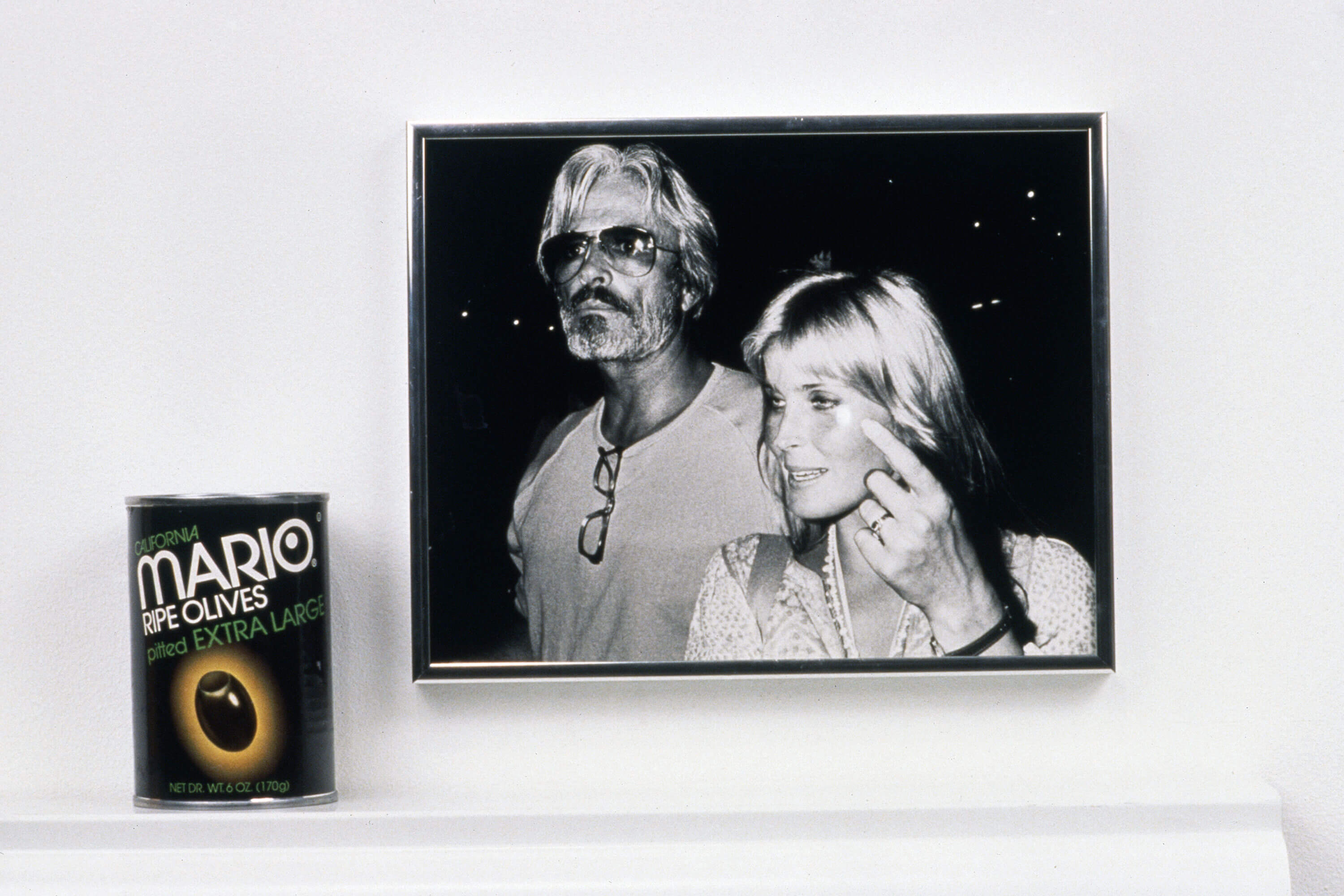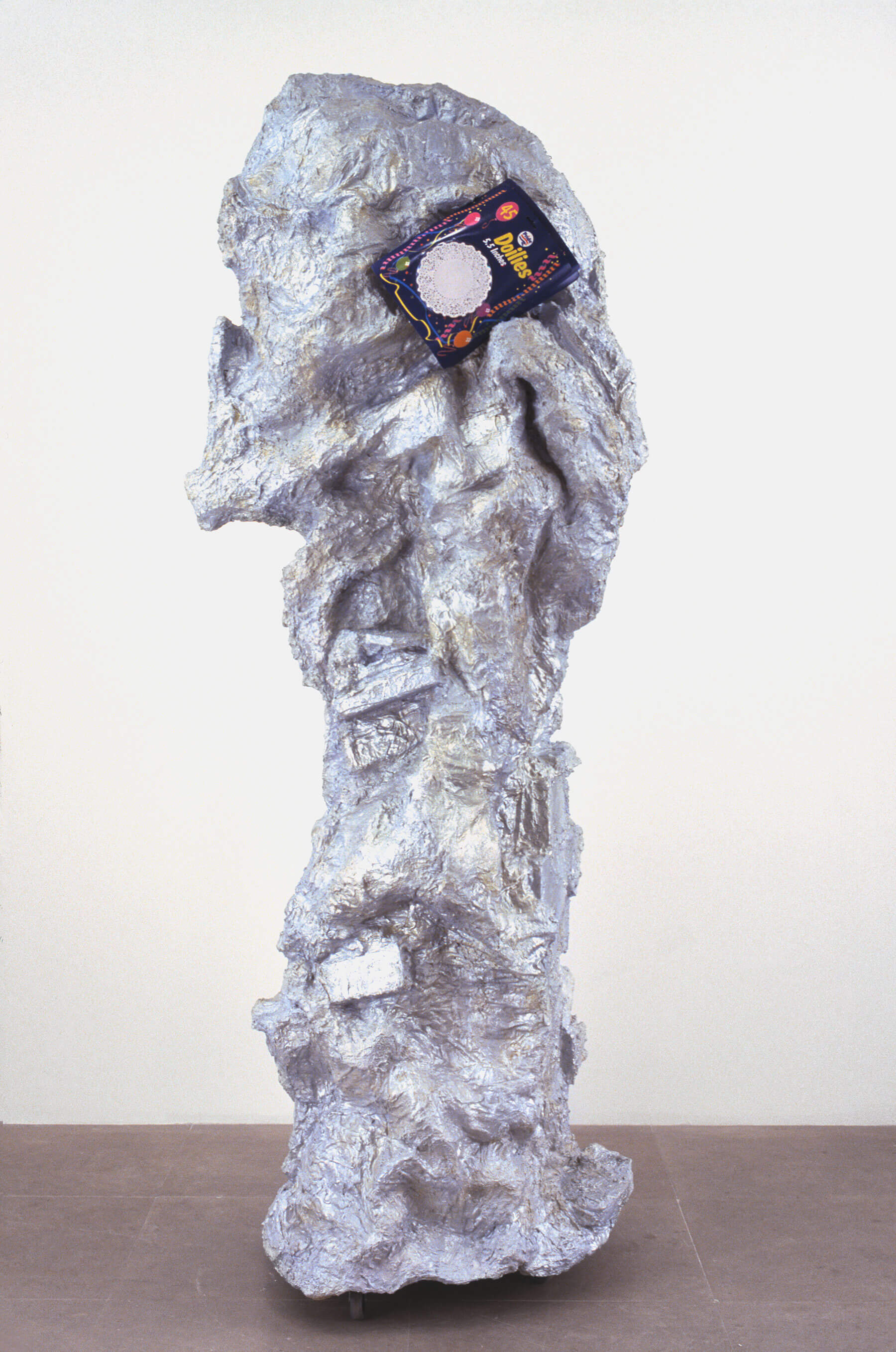rachel harrison essay (untitled) (no, literally untitled; that’s not the title)
Eva Hagberg Fisher
January 30, 2017

I know that I met Rachel Harrison at a party. In my memory, it was at a party for architect Galia Solomonoff’s West Village carriage house, built for art collector clients who put a Rirkrit Tiravanija mirrored installation in the front room, which was visible from the street, and in which I hid.1 Confoundingly, in a similar and overlapping memory, I met Rachel Harrison at a party thrown by a former member of the Architectural League of New York, which I know is absolutely impossible as I had never heard of Rachel Harrison when that party happened.
Just as confoundingly, and in yet another iteration of my memory, I met Rachel Harrison at one of the many events that I used to go to, the kind of events I used to say were a party for a chair or a sofa (because they were) or an envelope (because I liked to steal bad jokes), i.e. the kind of events that, if you were in New York City and somewhat affiliated with design or art, kept the engines humming, sometimes running, between 2003 and, well, I left in 2009. They might still be going.
I can absolutely one hundred percent truthfully and accurately recount that I did hear her speak at the New School, at a lecture I went to either with my friend C_, who got his MFA there and then published a memoir about reading the Harvard Classics, or with my ex-boyfriend, a minimalist sculptor whose name I will never publish.
While the minimalist sculptor and I were breaking up, he said to me: “One day, soon, you will be an anecdote.”
I asked him what he meant.
“One day someone will ask me about my life and I will say, ‘I dated a writer once.’”
To him I say now:
I am sorry for the brusqueness of this anecdote.
***
Rachel Harrison is an American artist who is known for her “assemblage” work. Rachel Harrison is an artist of whom the critic and theorist and historian Hal Foster, who was incidentally my preceptor in a contemporary art history seminar 15 years ago, says: “She takes a bad thing and makes it worse,” a line that Peter Schjeldahl, art critic of the New Yorker, wants us to know was said “approvingly.”2
It is moderately embarrassing to be writing an essay about an artist whom I can’t remember much about, whom I’ve seen speak once, whose work feels anecdotal, and yet about whom I believe I have what The OA would say is “perfect feeling.”
Schjeldahl, in his New Yorker article (which I read after writing a first draft of this, adding some sort of Jenga tower of legitimacy to this project, my own assemblage [it’s homage! homage! though also perhaps enlivened pastiche]), made me feel better about this elusiveness, and also about the unshakeable sense I have had since I saw her speak however many years ago, and especially since I met her however many years ago + the many years that passed, which is that Rachel Harrison gets something that I am almost always on my way to trying to get. Schjeldahl calls this skill “formal command” and “rhetorical specificity,” and says that this combination makes her work feel destined.
At the New School, she talked about her Bo Derek and olives piece, which Google has confirmed is called “Teaching Bo to Count Backwards.” I can’t remember what she said about the artwork, but I like thinking she might have said “I like Bo, and I like olives…”
When I met my now-husband, I used words like “destined.” I did not use phrases like “formal command” and “rhetorical specificity,” though the way that he fit into my life was extremely specific and also rhetorically ideal. We met while I was trying to figure out if I had a brain tumor that would kill me. I was in the middle of waiting, in this sort of interminable middle ground that I had never known existed but that suddenly took up all the air around me, that became the water I swam in.
When I met my now-husband, I used words like “destined.” I did not use phrases like “formal command” and “rhetorical specificity,” though the way that he fit into my life was extremely specific and also rhetorically ideal. We met while I was trying to figure out if I had a brain tumor that would kill me. I was in the middle of waiting, in this sort of interminable middle ground that I had never known existed but that suddenly took up all the air around me, that became the water I swam in.
He showed up and there he was. I liked him. He liked me. So we put ourselves together.
Rachel Harrison is an American artist who has a piece currently on show at the San Francisco Museum of Modern Art, a new building designed by Snohetta that opened this year to moderate-to-great fanfare. Almost everyone liked it except for the British critics, like Oliver Wainwright, who are always really the best to read about architecture anyway, and so he, for one, called the SFMOMA some kind of failed meringue wedding cake. That anecdote is from my memory, and has also been confirmed.3
It’s a huge museum, now the largest modern art museum in the country.
When I was with that artist, the one who said he would turn me into an anecdote, there was a night when we stood on 23rd Street. We used to walk in the city, every so often, maybe to a gallery (his gallery) or to some other gallery (not his gallery), to look at artists like Tara Donovan or Roy McMakin (at not his galleries). I remember that it was dark, and that we were standing on the street waiting for a taxi? the bus? who can remember—I’ve become an anecdote—I’ve become my own anecdote—and he started yelling
SARAH
SARAH
SARAH
SARAH
I was in a period of my life, a period in which I am still, in which I cannot bear to contemplate my beloved ever having belonged to someone else.
He was actually yelling
SERRA
SERRA
SERRA
SERRA

There was a truck-train of Serra parts being transported down 23rd Street, away from their temporary MoMA home and, even as none of us knew it yet, were possibly on their way, at least partially, or at least conceptually, or at least something like it, to the new SFMOMA.
Rachel Harrison is an American artist whose piece is up at the SFMOMA. I saw it there a few months ago on a visit with my in-laws. After the artist, I dated someone else, and then I dated someone else, the destined one, and then I married him.
The piece at SFMOMA is a big assemblage with a video screen.
My father-in-law walked right past it. So did my mother-in-law. So did the couple we were with.
But I had to stop.
An ARTnews review—of the building—says that the Harrison piece on display at the SFMoMA is a “minor” piece. The article doesn’t name the piece.4 I had to do some very creative search engine work to find the title. I think it is called “Hail to Reason.” It is a big gray thing with some other things in it. It looks like a woman bending in on herself. Or like a pile of rocks. Or like a vagina. Maybe I’m projecting.
Rachel Harrison is an American artist who, when I met her at this party of which I have a perfect memory, absent any spatiotemporal coordinates, said, “Do I know you?” probably because I had been staring at her intermittently and trying to figure out how to introduce myself. I said, “No, but I’ve seen you talk and I really liked it,” and she said, “I could feel that you were kinda vibing me,” except she didn’t say it like that, it was something sort of like that, and I said, “I’m sorry that I was staring, I should have just come and said hi,” and she said, or I remember her saying something to the effect of, “That’s fine, I just, it’s kind of weird to do that, you know, like just say hi or something, because I just didn’t know if I knew you,” and I said, “Ugh, I know,” and I left, and I thought never to think about this again.
Except I have never stopped thinking about Rachel Harrison; not the shame of our encounter, but the way her performed freedom gave me a metric for how to perform my own.
Whenever I actually met her, it was important to me, so important that I can remember it only as anecdote now. She might have thought I was weird, might still think I was weird, but for the last seven years, or however many years, nine, ten, it’s been since I met her or heard her speak, maybe even eleven, just adding here, adding more and more and more stuff, like going shopping in my memory bank, I’ve been trying to open myself up to art as some kind of concept, like, what is the point of art if not to be able to combine Bo Derek with olives just because you like Bo Derek and olives, and so what is the point of writing if not to be able to combine memories of SERRA and SARAH and SOLOMONOFF and HARRISON?
Rachel Harrison is an American artist who mentioned Dada at her lecture but then said she doesn’t do it.